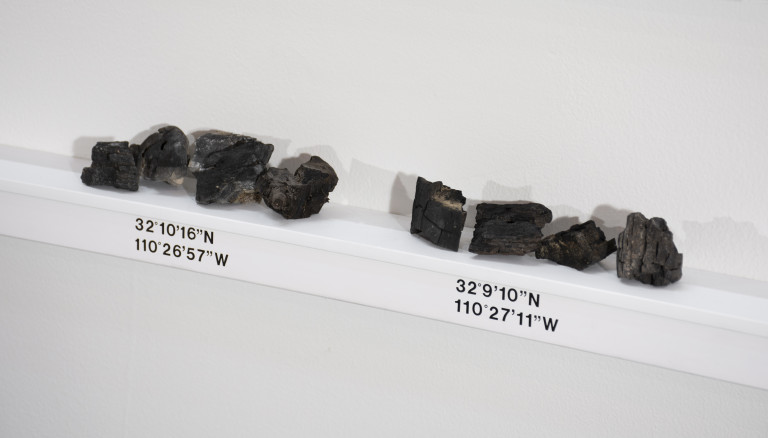Catalina-Rincon Panorama

Julie Comnick, artist:
Contrast. Inversion. Black and white. Negative and positive. Catalina-Rincon Panorama is one image that shows the contrast between two landscapes: one is inhabited by humans and wildfire is suppressed, and the other is not. Catalina-Rincon Panorama is rendered with wildfire charcoal collected from wildfire sites on two adjacent mountains outside of Tucson, Arizona. The density of charcoal in the drawing reflects the relative frequency and severity of wildfires in recent history. The charcoal samples used to create the drawing are displayed in proximity to each wildfire site.
The Santa Catalina Mountains are Tucson’s most prominent range with the highest peak of the Sky Islands on Mt. Lemmon (elev. 9147 ft). The inhabited areas include Summerhaven, Ski Valley, and Sabino Canyon, accessible by the Catalina Highway (General Hitchcock Highway). The Rincon Mountains, by comparison, peak at Mica Mountain (elev. 8668 ft). The wilderness is vehicle-accessible only by Mescal Road (Forest Road 35), so the wilderness remains remote despite its close proximity to Tucson.
Herein lies the disparity that serves as the basis for this drawing. From a bystander’s perspective, the Santa Catalina Mountains appear green. The higher elevation range allows for diversity in the vegetation, ranging from saguaro to aspen forests. Due to human inhabitation, fires are suppressed. This results in dense vegetation capable of producing high severity mega-fires. The Rincon Mountain Wilderness, on the other hand, appears brown. At a lower elevation, the ecosystem ranges from desert chaparral to ponderosa pine. Since this is uninhabited wilderness, naturally occurring wildfires are permitted to take a natural trajectory. Vegetation is reduced through regular wildfire cycles so fires are typically smaller and manageable. Ironically, while the Santa Catalina appears to be the healthier of the two mountains, the Rincon Wilderness is the more sustainable environment.
The Catalina-Rincon Panorama was displayed at the Tree-Ring Lab August 2018- May 2019.
For more on Julie Comnick's work, please visit: http://juliecomnick.com/


